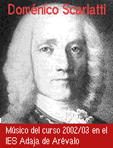 |
| |
| Biography |
|
|
Domenico Scarlatti was born on the
26th of October, 1685; in Naples, son of Alessandro Scarlatti, a famous opera composer.
Born in the same year as Johann Sebastian Bach, both were masters of music of the
Baroque period, which lasted from about 1600 to 1750. Both also wrote a great deal
of music for the harpsichord. But whereas Bach in Germany followed an established
tradition of writing fugues and other types of music with strict rules, Scarlatti
lived and worked in Italy, Portugal and Spain, where different musical traditions
prevailed. With the harpsichord, he took a free and independent line and was a highly
influential figure in the development of keyboard musics.
Alessandro Scarlatti's ambitions for his son led to various appointments composing
opera and church music. Domenico's first thirty-five years were busy but undistinguished
as he played the harpsichord, composed Masses for St Peter's, operas for Venice and
Naples, and concertos and chamber works for anyone who asked. He achieved some fame
as the finest harpsichordist of his day, but his compositions were merely competent
and cannot be considered particularly inspiring.
In 1709 Scarlatti became harpsichord teacher to the exiled Polish Queen, Maria Barbara
Casimira, in Rome. When she became Queen of Spain eight years later he followed her
to Madrid and stayed there for the rest of his life. This appointment enabled Scarlatti
to devote himself to his first love, the harpsichord. This is the turning point of
Scarlatti's career as a composer. For Maria Barbara, he composed over 500 harpsichord
pieces, works of such dazzling brilliance that they place him abruptly in the front
rank of composers.
In his hundreds of single-movement sonatas or esercizi (exercises) for the harpsichord,
Scarlatti developed exciting new techniques such as rapidly repeated notes and crossing
one hand over the other, and experimented with new kinds of musical form. Here he
was a true pioneer and an important link between the Baroque period and the musical
forms and styles of the Classical period that followed in the 18th century.
Although Scarlatti's famous exercises were originally written for the harpsichord,
today they are more often played on the piano. Imaginative and graceful, the music
of Scarlatti often seems to dance easily over the keys, almost as though it composes
itself. At other times, it is more reflective or subdued. Always, though, the breathtaking
range of moods and techniques is both adventurous and a sheer delight to listen to.
The influence of Scarlatti is often underrated. Certainly he anticipated many of
the developments of the Classical period, and his hand is seen in the works of Haydn,
Mozart and Beethoven (the three composers who represent the first classic phase of
the sonata).
Domenico Scarlatti died on 23 July, 1757 in Madrid. |
|